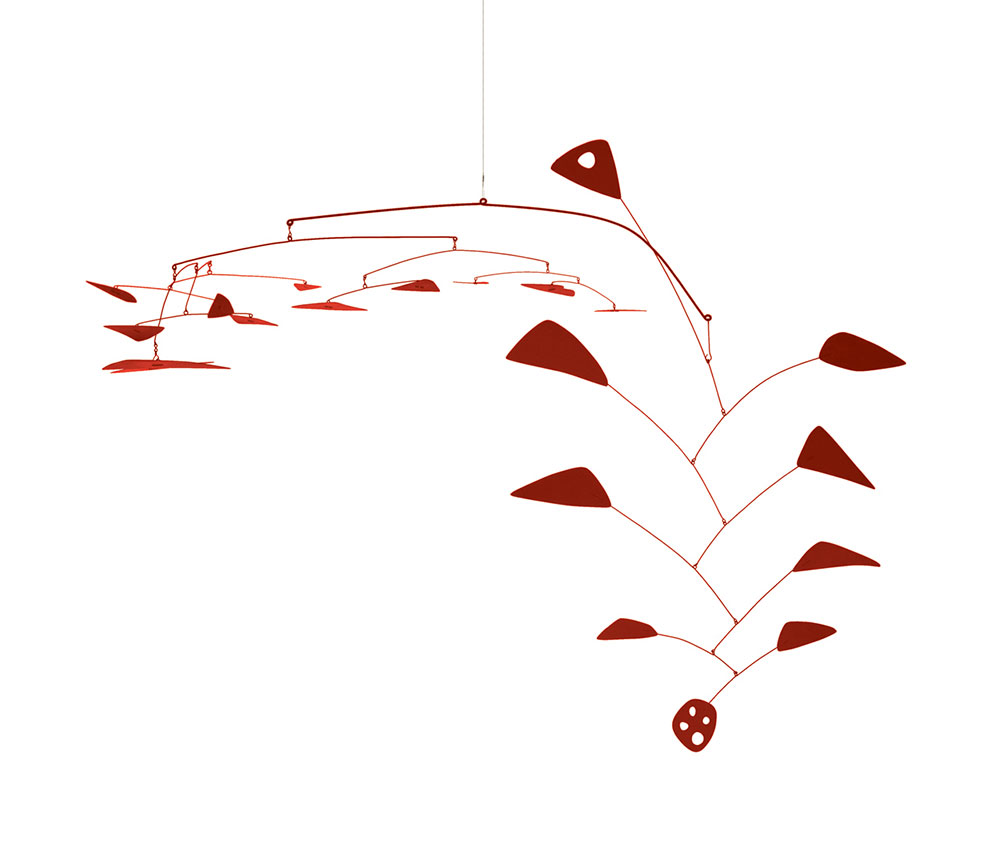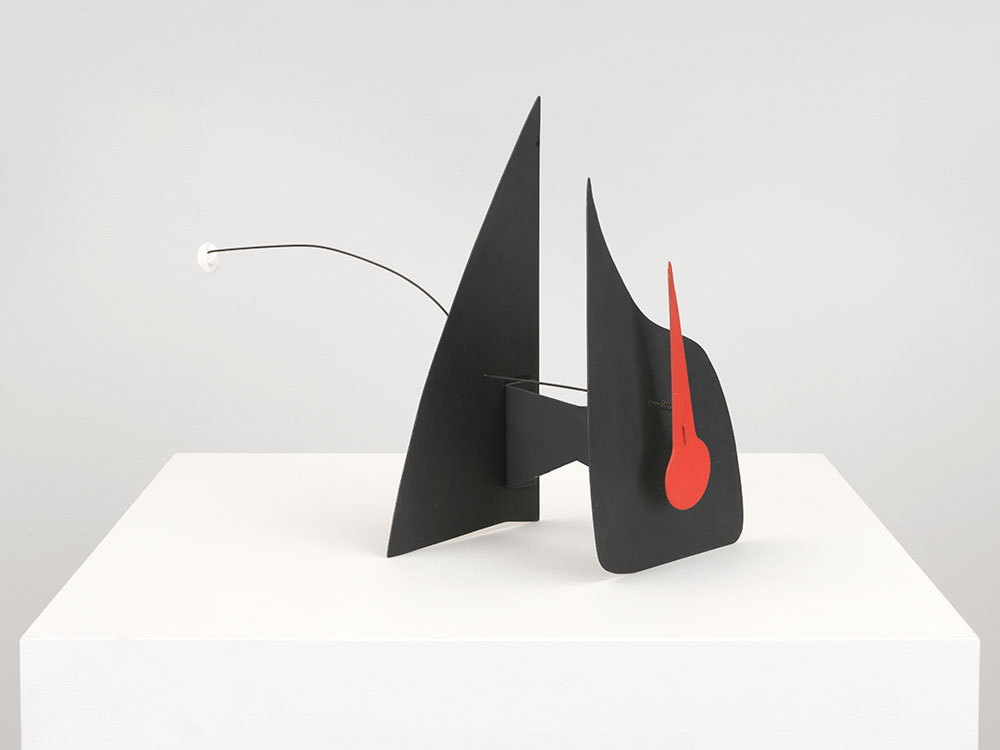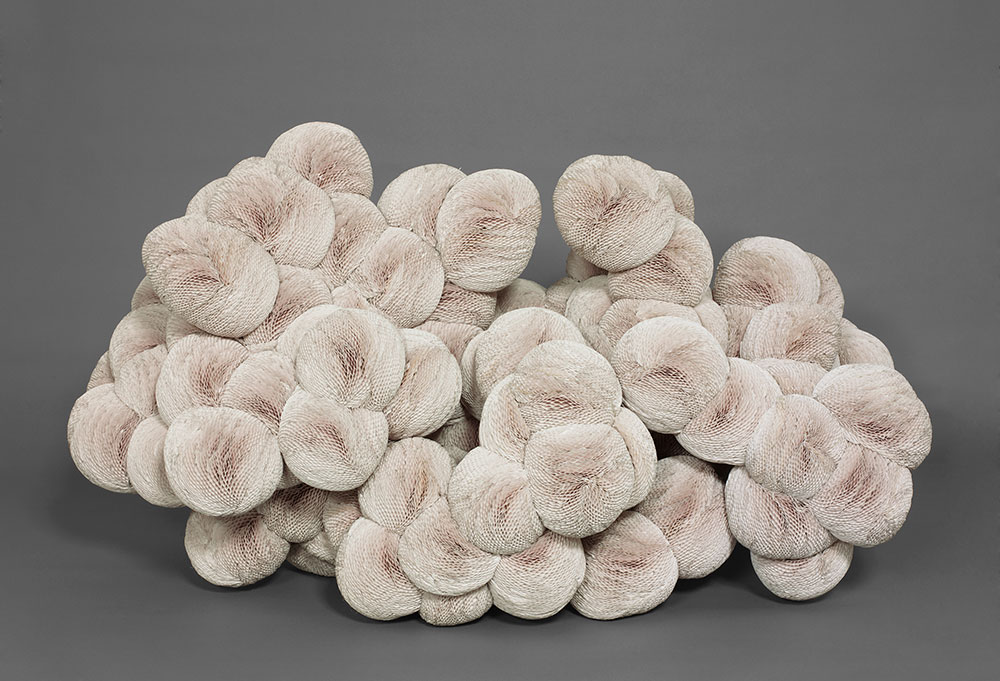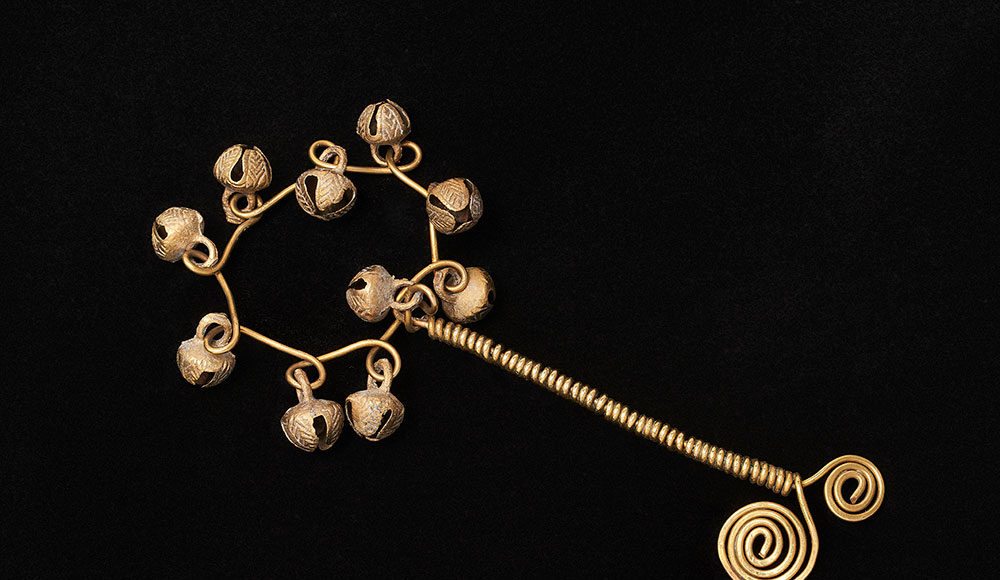The new exhibit Calder: at home, among friends is more of an amuse bouche than a full-course meal. The scale of Alexander Calder’s work on display (at the San José Museum of Art through Aug. 3, 2025) is delicate rather than imposing—an intimate survey of his life (1898–1976) and the works of art he made for members of his family and his friends.
Calder’s large sculptures are displayed elsewhere in the Bay Area—on Stanford’s campus (Le Faucon,1963) and at UC Berkeley near a redwood grove (The Hawk for Peace,1968). His 27-foot-long mobile Untitled (1963) hangs at the Chase Center in San Francisco. Both the San Francisco Museum of Modern Art and the Berkeley Art Museum and Pacific Film Archive have more work by Calder as part of their permanent collections.
But Calder’s connections here are also more intimate—as the title of the exhibit suggests. In a recent social media post, the Calder Foundation mentioned the opening of San Jose Museum of Art’s Calder: at home, among friends. “Many of the works on view are gifts Calder made for his sister, Margaret ‘Peggy’ Hayes.”
Peggy’s daughter-in-law was none other than Janet Gray Hayes, mayor of San Jose from 1973 to 1983—and the first woman elected mayor of a major U.S. city with a population of more than 500,000 people. The former mayor’s house was adorned with work by Calder. The post continues: “In her memoir, Three Alexander Calders, Peggy reflects often on her brother’s generosity, describing the numerous artworks he created for her and her family over the years.”


Janet Gray Hayes is linked not only to this SJMA show but also much broadly to the museum and its history. Active in cultural affairs after she left office, Hayes became president of the board of directors for the San Jose Museum of Art—a time when, according to her obituary, the museum was on the verge of bankruptcy. Working with staff and board members, Hayes brought the Anne Frank exhibit to the museum, which broke attendance and revenue records. The museum’s portico was dedicated to Janet Gray and Kenneth Hayes.
In one of SJMA’s smaller upstairs galleries, Calder: at home, among friends can be savored as an introduction to and a distillation of the varieties of media the artist mastered. The first image visitors see on the way inside is a wall-length black-and-white photograph of Calder at work in his studio. To describe the aerial view inside the studio as cluttered is an understatement. But it provides a clear picture of every material—wood, metal, paper, paint, ad infinitum—that Calder shaped and bent and reformed to make his mobiles, sculptures, drawings and paintings.
Alexander Calder (1998), an episode of the PBS series American Masters written by Thomas McNamee, is an informative companion to the SJMA show. The hour-long documentary provides the biographical context for each successive phase and the expansion—both literal and figurative—of Calder’s artistic vision. After studying for and then abandoning an engineering career, he applied his education, and skills as a draftsman, toward the inauguration of an art practice that endured for decades.
With a busy pair of hands that seldom seemed to rest, he started out by making tiny wire figurines come to life. A few of these sculptures are displayed as part of Calder: at home, among friends. There’s also a belt buckle in the shape of fish that has swallowed a hook. Two brooches (1938-1939), an eight-petaled flower made of brass and a butterfly in brass and steel wire, show off his manual dexterity coupled with a sense of whimsy. Initially, they don’t connect to or, in any obvious way, foreshadow his late sculptures.


A few smaller colorful sculptures, made of sheet metal, wire and paint, capture the development of Calder’s imagination. They look like initial prototypes of grounded mobiles, before Calder raised them skyward, and iterations of the outdoor sculptures before the artist expanded their scale, mass and density.
Calder’s mobiles mark the transition and connection between the small wire sculptures and the monumental ones. The largest piece in the exhibit, Big Red (1957), is a mobile also made from sheet metal, wire, and red paint that he made for his sister. Every one of its triangle-shaped leaves or pennants, some pointing up like shark fins, casts an array of shadows on the gallery walls and floor. Even when it’s still, Calder effectively suggests the idea of flight and motion.
In the same gallery, SJMA has included a secondary exhibition Still in Motion which includes the work of four artists who’ve received the Calder Prize. The Calder Foundation, which operates out of New York, awards the prize biennially to “a contemporary artist whose innovative work reflects the continued legacy of Calder’s genius.”
Tomás Saraceno’s sculpture Calder Upside Down 28/18/15/12/8 (2018) is the Still in Motion piece that most obviously reflects one of Calder’s mobiles. Saraceno’s hand blown glass spheres are suspended upside down, as the name suggests, as if they’re defying gravity by falling, and/or rising, upward.
I confess that after watching a few minutes of Aki Sasamoto’s movie Delicate Cycle (2017) I could only discern a very thin line that could connect her work to Calder’s. Described by art21.org as “deadpan” and “absurdist,” Sasamoto speaks to the audience while creating art at the same time. In order to engage with this manufactured improvisation, the viewer must approach the film with an indulgent and patient state of mind.
Jill Magid’s Hand-hacked Bouquet 1 (Out-Game Flowers) is mounted vertically on a TV screen to the side of Calder’s studio photograph. The soundtrack, a tune plunked out by an electronic fairy who’s high on pollen, casts a spell in the gallery as it plays over a rotating bouquet of digital flowers.
I reached out to Magid to ask what winning the prize meant to her. She emailed me to say, “I was excited and honored to win the Calder Prize, and to share that honor with other artists whose work I admire and feel close to, such as Rosa Barba—who is also a friend.” Magid added, “I think it is exceptional that the Calder Foundation supports contemporary artists through this prize—what a way to grow the legacy of one artist by helping other artists to thrive.”


Tara Donovan is the fourth artist featured in Still in Motion with her sculpture Untitled (Paper Plates) (2005). Donovan also wrote me an email describing her connection to Calder. “The San José Museum of Art exhibition focuses on many of the objects Calder created for personal use, which is an issue I always take into account in the development of my own work.” Her Untitled (Paper Plates), she wrote, “focuses on the scalloped edges of the plates as an organizing principle to create a sculptural object amplifying optical patterns and movement as viewers experience it.”
Winning the Calder Prize gave Donovan “a chance to find the time and space to pursue some larger projects that otherwise wouldn’t have been possible at the time.” She added that Calder’s legacy and influence on subsequent generations of artists, “lives on not only in the works he left behind, but also in the ideas and motivations he continues to inspire.”
Calder: at home, among friends is now on view at the San José Museum of Art through Aug 3, 2025. 110 S Market St, San Jose. sjmusart.org



